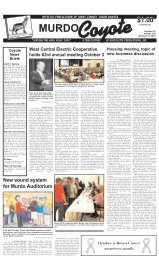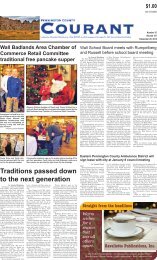You also want an ePaper? Increase the reach of your titles
YUMPU automatically turns print PDFs into web optimized ePapers that Google loves.
Agriculture …<br />
Winner Regional Extension Center<br />
Bob Fanning, Plant Pathology Field Specialist • 605-842-1267<br />
Minimizing Losses<br />
in Hay Storage<br />
Many areas are experiencing<br />
low hay yields in 2012, and with<br />
hay prices at high levels, minimizing<br />
storage losses is increasingly<br />
important.<br />
One of the most economical hay<br />
production packages is large round<br />
bales. This is primarily because of<br />
low labor requirements. However,<br />
storage losses are often substantial.<br />
Making a well-formed, dense<br />
bale is the first step toward reducing<br />
storage losses. Moisture content<br />
at baling also plays an<br />
important role. If hay is too wet,<br />
quality can decrease due to heating<br />
and molds. Baling too dry can<br />
cause baler losses to increase dramatically.<br />
Round bales should be<br />
baled at 15 to 20 percent, with the<br />
ideal moisture content about 17<br />
percent.<br />
Storage method and length of<br />
storage period have a tremendous<br />
impact on weathering losses.<br />
Barn-stored hay suffers significantly<br />
less weathering loss than<br />
unprotected hay stored outside.<br />
Dry matter losses for barn-stored<br />
hay are typically in the 2- to 8-percent<br />
range. Covering outside<br />
stored hay can also reduce weathering.<br />
Hay stored outside will continue<br />
to deteriorate as long as it is<br />
stored, however most spoilage occurs<br />
early in the storage period.<br />
Large round bale storage losses<br />
can easily exceed 25 percent when<br />
bales are stored outside, unprotected,<br />
but losses can be minimized<br />
through good management.<br />
If outside storage is the chosen<br />
method, pay close attention to selecting<br />
a storage site and stacking<br />
method.<br />
A well-drained site minimizes<br />
deterioration on the bottom of the<br />
bale. Bales stored on damp soil absorb<br />
moisture that causes damage.<br />
If possible, elevate bales by stacking<br />
on old tires, shipping pallets or<br />
railroad ties. Adding a base layer<br />
of 3- to 4-inch crushed rock to the<br />
storage site will also help minimize<br />
losses at the bottom of bales.<br />
Storing bales on the ridge of a hill<br />
instead of near the bottom will also<br />
reduce bottom deterioration.<br />
Weeds or tall grass at the storage<br />
site will increase deterioration of<br />
the bottom of the bale.<br />
Round bales stored outside need<br />
air circulation and sunlight to help<br />
dry the outer layer after a rain.<br />
Storing the bales under trees<br />
blocks wind circulation and sunlight,<br />
which helps dry the bales.<br />
This Ad<br />
will<br />
vanish<br />
in seconds<br />
if we put<br />
it on<br />
the radio.<br />
SEEING<br />
is<br />
BELIEVING<br />
Ravellette<br />
Publications, Inc.<br />
with offices in:<br />
Kadoka<br />
605-837-2259<br />
Philip<br />
605-859-2516<br />
Wall<br />
605-279-2565<br />
Faith<br />
605-967-2161<br />
Bison<br />
605-244-7199<br />
Murdo<br />
605-669-2271<br />
New<br />
Underwood<br />
605-754-6466<br />
Any protection that trees might<br />
offer from rain is more than offset<br />
by the damage due to the shading<br />
they provide.<br />
Bales are sometimes stored individually<br />
without touching other<br />
bales for ease of handling with<br />
equipment that grabs the bale<br />
from both ends. If stored individually,<br />
leave at least 12-18 inches between<br />
bales for air circulation.<br />
Storing bales with the rounded<br />
sides touching is not recommended.<br />
This creates a trap for<br />
rain and snow. The bales may be<br />
easier to handle with some equipment,<br />
but losses will be higher.<br />
Tightly aligning bales end to end<br />
better utilizes storage area and<br />
protects the ends of the bales from<br />
weathering. Leave 12-18 inches<br />
between the rounded sides to avoid<br />
trapping rain or snow. Aligning<br />
rows north-south allows equal<br />
amount of sunlight on both sides of<br />
the row.<br />
Stacking bales in pyramids is<br />
popular to save space, but can result<br />
in high levels of loss due to<br />
rain and snow accumulation at the<br />
junction of the layers. Stacking<br />
bales by turning one bale on end,<br />
with another on top (rounded side<br />
up) reduces losses to nearly as low<br />
as bales stored in rows, one bale<br />
high, but also saves space. Plastic<br />
bale covers or bags can reduce<br />
losses, but they should be fastened<br />
securely to the bale so the wind<br />
will not tear them.<br />
Calendar<br />
6/21/2012: SDSU CPT Winter<br />
Wheat Variety Plot Tour, 5:30 p.m.,<br />
Ideal, SD<br />
6/28/2012: Dakota Lakes Research<br />
Farm Tour, 3:00 p.m. –<br />
dark, 17 miles east of Pierre, SD<br />
on Hwy 34<br />
<br />
<br />
<br />
<br />
<br />
<br />
<br />
<br />
<br />
<br />
<br />
<br />
<br />
<br />
<br />
<br />
<br />
<br />
<br />
<br />
<br />
<br />
<br />
<br />
<br />
<br />
<br />
<br />
<br />
<br />
<br />
<br />
<br />
<br />
<br />
<br />
<br />
<br />
<br />
<br />
<br />
<br />
<br />
<br />
<br />
<br />
<br />
<br />
<br />
<br />
<br />
<br />
<br />
<br />
<br />
<br />
<br />
<br />
<br />
<br />
<br />
<br />
<br />
<br />
<br />
June 21, 2012 • Kadoka Press • Page 10<br />
<br />
<br />
<br />
<br />
<br />
press@kadokatelco.com

















